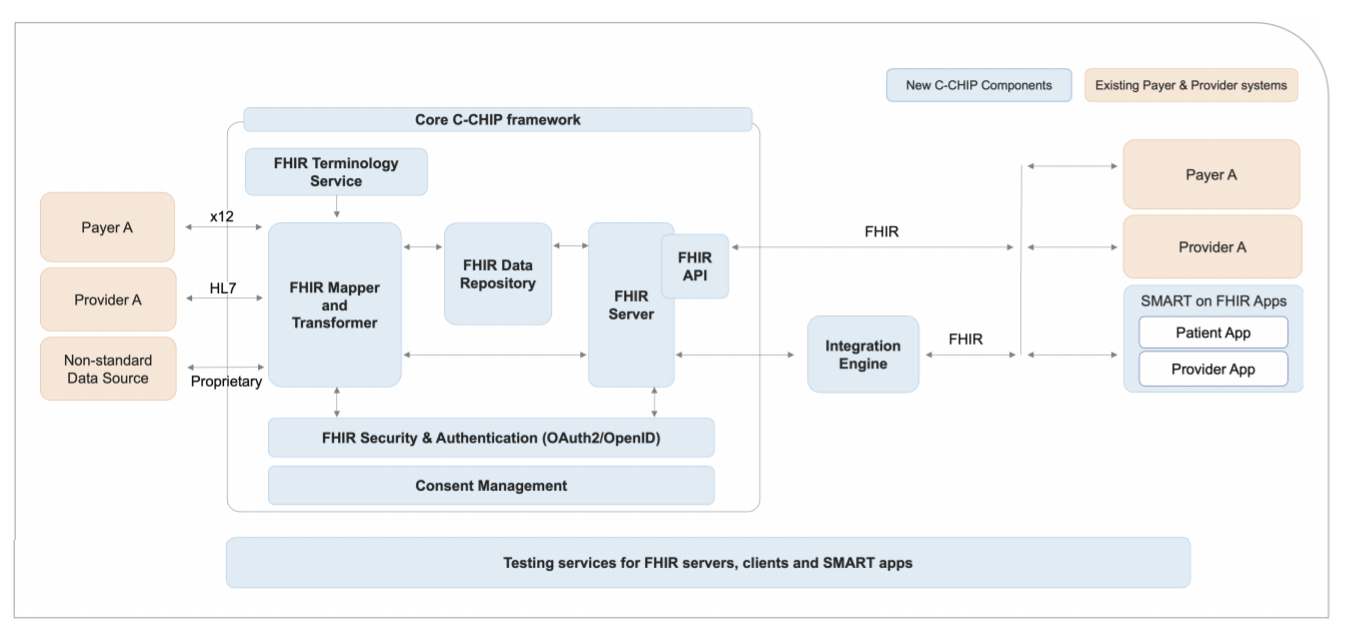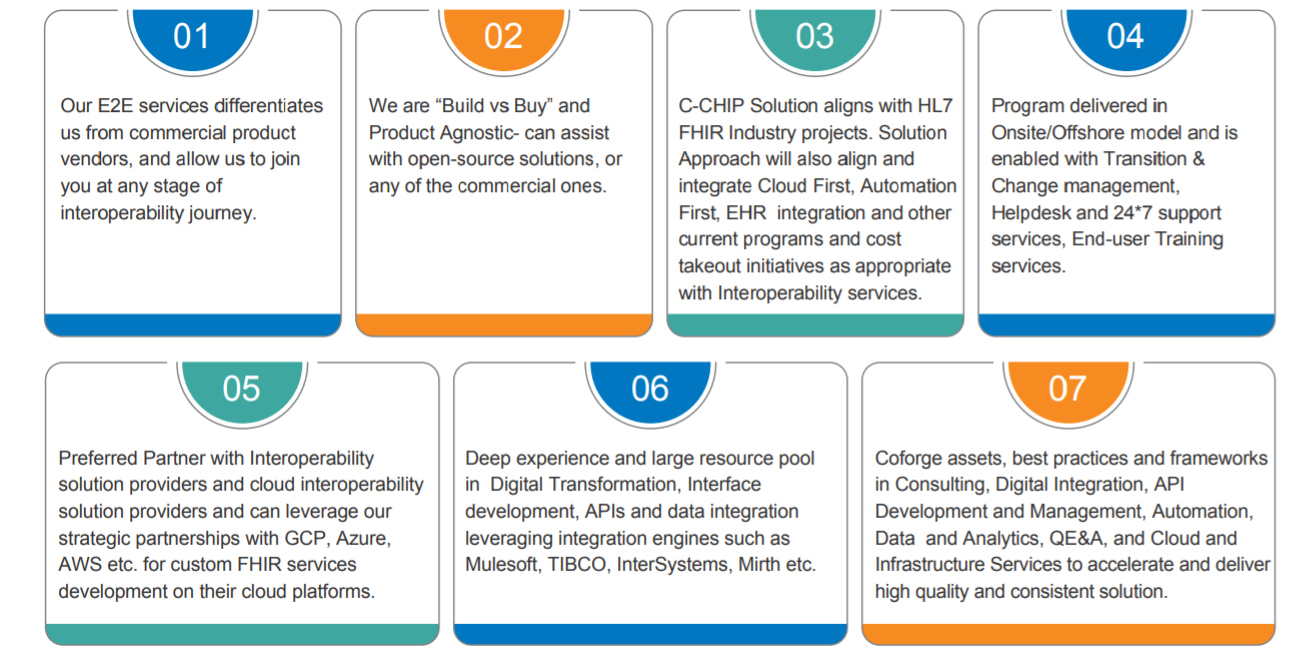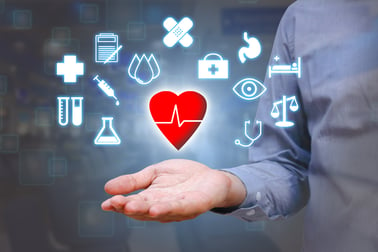Coforge Connected Health and Interoperability Program (C-CHIP), pronounced as “see-chip”, is focused on transforming Healthcare ecosystem with transparent, controlled and monitored information sharing capabilities that enhance quality of care, significantly improve operational performance, and enrich consumer engagement and satisfaction.
C-CHIP is a complete Interoperability Enablement Program Stack that solves the challenges Healthcare Ecosystem is facing with information sharing among all the stakeholders of Patient Health, by enabling timely implementation of CMS Interoperability Regulations and by integrating various interoperability and information sharing initiatives to maximize the benefits in Clinical and Financial information sharing across the Healthcare Value Chain.
C-CHIP builds off of the work being done by industry projects such as Da Vinci, Argonaut, CARIN, Vulcan, Gravity etc. in leveraging HL7 FHIR standard to build an interoperability stack and bring industry-established guidelines to future-proof our clients’ journeys towards seamless interoperability. With these industry projects driving the way forward to interoperability mandates such as 9115 and 9123, it is important for every healthcare enterprise to build a roadmap leveraging the standards and implementation guidelines laid out by these projects so that the organization’s capabilities, solutions and services are in sync and compliance. C-CHIP provides the flexibility and adaptability needed to become compliant today and remain one in future.

Figure 1 How C-CHIP leverages Industry projects?
C-CHIP factors in all of the primary and supporting business drivers listed below to partner with Clients in Interoperability enablement and to provide them the best value CMS Interoperability mandates (CMS 9115 & 9123) accelerating the need for adoption Natural alignment of Interoperability program with Digital Transformation Initiatives such as API First, Cloud First, Process Automation, Blockchain, IoT/IoMT and Embedded Analytics at enterprise level atient-centric care and Consumerism driving data transparency and patient ownership of data
-
Acceleration of Virtual Care and Remote Patient monitoring needs since the Pandemic
-
Healthcare organizations started adopting APIs at enterprise level, powered by cloud technologies
-
Meaningful Use requirements led to EHR adoption building the foundation for interoperability
-
21st Century Cures Act recommending no information blocking and called out patients as the owners of their data
-
Value based contracts making providers take a forward-looking, strategic approach and leverage patient data for better outcomes
-
Population Health Management, Chronic Care Management and Leveraging SDoH data further drives the transformation
-
Significant potential to improve process efficiencies through Patient Information sharing
C-CHIP Stack
C-CHIP Stack includes C-CHIP Solution Framework that aids the development of core solution and C-CHIP Engagement Framework that offers a client engagement framework for end-to-end Interoperability enablement. C-CHIP Solution Framework (Fig 2), gives the view of the core solution components that Coforge will build, integrate and implement leveraging open-source assets or COTS products to enable the Customers with end to end Interoperability with the Patients and Trading Partners.
A view of how C-CHIP solution framework enables Payer and Provider Integration with the Core components is depicted in the below diagram.

Figure 2 Indicative C-CHIP Solution Framework
C-CHIP also offers an engagement approach with a defined Engagement Framework (Fig 3) that can be adapted to the client’s interoperability transformation journey. We understand that different clients are at different stages of their adoption and evolution, and hence our engagement approach allows us to join our clients as a partner at any stage of their journey as well as be their partner at every stage. C-CHIP Current State Assessment focuses on reviewing all of the key client programs e.g. Automation First, Cloud First and API First etc. and client’s overall Digital Strategy to factor in and integrate the key aspects of the ongoing programs into the Interoperability Initiative.

Figure 3 C-CHIP Client Engagement Framework
Summary
C-CHIP integrates value from leading industry projects such as Da Vinci, Argonaut, Vulcan, CARIN Alliance, and Gravity to align our services in sync with industry best practices. The C-CHIP framework helps Healthcare Payers, Providers and Life Sciences firms build a FHIR-based ecosystem to comply with interoperability mandates and enable seamless clinical and operational data sharing among all stakeholders. Our framework brings in flexibility to leverage both in-house and partner products for a holistic approach. A summary of key differentiators for our interoperability program approach have been illustrated in the diagram below.

Figure 4 C-CHIP Key Differentiators
We take pride in the fact that Coforge's extensive domain knowledge clubbed with deep expertise on digital transformation and class leading partnerships enables us to engage at every stage of your Interoperability enablement program, starting from current state assessment, defining future state, building and implementation, validation, and deployment and governance.





-1.jpeg?width=378&height=290&upsize=true&upscale=true&name=Pandemic-sized%20collaboration%20transforms%20the%203%20Ps%20of%20Healthcare%20(1)-1.jpeg)

